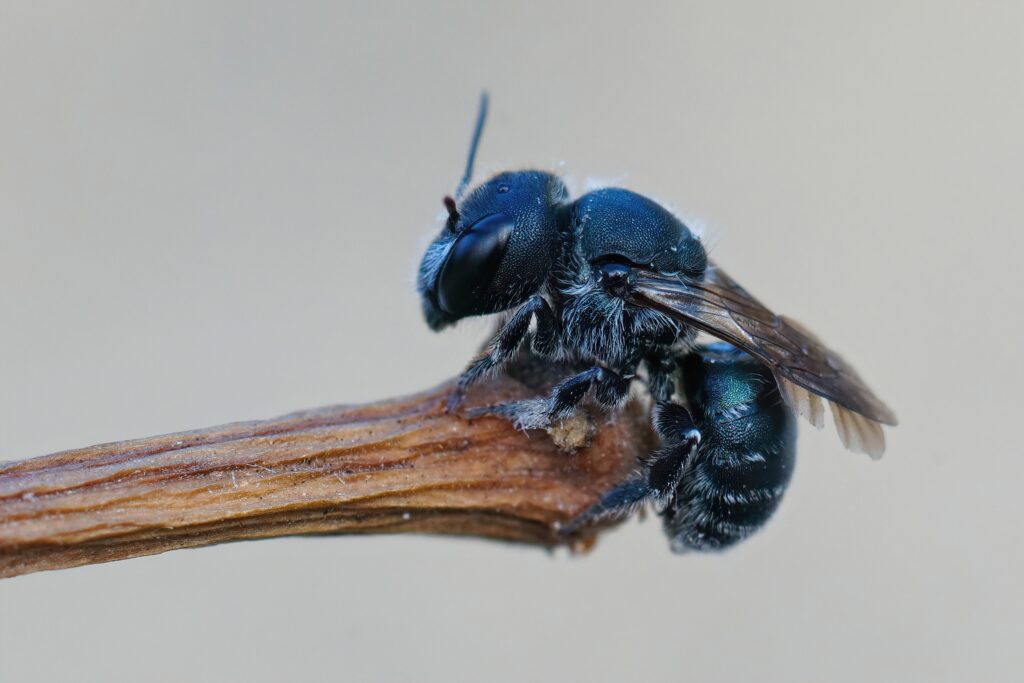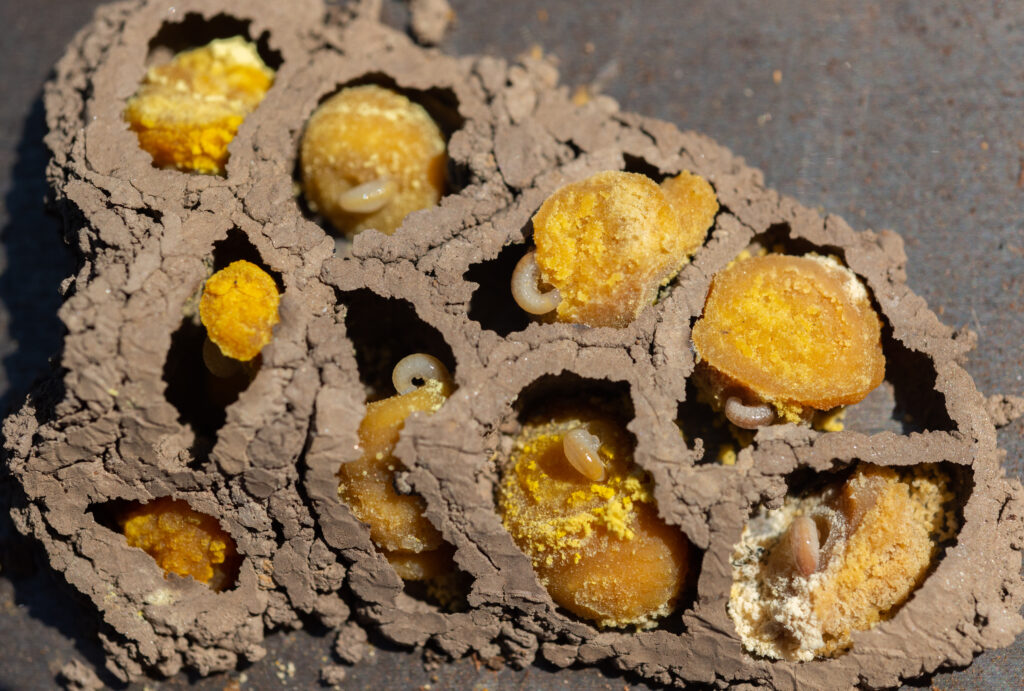Mason Bee
Studies have shown that 250 to 300 mason bees can do the equivalent work of 90,000 honey bees!
Advertisement
Mason Bee Scientific Classification
Read our Complete Guide to Classification of Animals.
Mason Bee Conservation Status
Mason Bee Facts
- Prey
- N/A
- Main Prey
- N/A
- Name Of Young
- larvae
- Group Behavior
- Solitary
- Fun Fact
- Studies have shown that 250 to 300 mason bees can do the equivalent work of 90,000 honey bees!
- Estimated Population Size
- Undetermined
- Biggest Threat
- habitat loss, agricultural chemicals
- Most Distinctive Feature
- iridescence
- Distinctive Feature
- Osmia avosetta lines her nest with flower petals!
- Gestation Period
- N/A
- Temperament
- mild
- Wingspan
- 0.3 - 0.75 inches (8 - 20 mm)
- Training
- N/A
- Optimum pH Level
- M/A
- Incubation Period
- 5-7 days
- Age Of Independence
- emergence
- Age Of Fledgling
- emergence
- Average Spawn Size
- 1-30 eggs
- Litter Size
- N/A
- Habitat
- forests, meadows, gardens, and orchards
- Predators
- wasps, birds, spiders, small mammals
- Diet
- Herbivore
- Average Litter Size
- N/A
- Lifestyle
- Diurnal
- Favorite Food
- flower nectar
- Type
- Osmia
- Common Name
- Mason bee
- Special Features
- buss pollinators
- Origin
- Global
- Number Of Species
- 300
- Location
- global
- Slogan
- N/A
- Group
- N/A
- Nesting Location
- Cavity nesters
- Age of Molting
- Various times throughout larval stage
Mason Bee Physical Characteristics
- Color
- Brown
- Yellow
- Blue
- Black
- Tan
- Green
- Dark Brown
- Cream
- Orange
- Skin Type
- Exoskeleton
- Lifespan
- 3 months - 1 year
- Weight
- less than 1 ounce
- Height
- 0.1-0.3 inches
- Length
- 0.3 - 0.75 inches (8 - 20 mm)
- Age of Sexual Maturity
- 1 day post emergence
- Age of Weaning
- N/A
- Venomous
- No
- Aggression
- Low
View all of the Mason Bee images!
Mason bees in the genus Osmia are a diverse group of solitary bees known for their important role in pollination. With over 300 species worldwide Osmia bees are distributed across all continents except Antarctica. There are over 100 species of mason bees in North America! They are commonly found in a variety of habitats ranging from deserts to forests. As cavity nesters, Osmia construct their nests using natural or manufactured cavities such as hollow plant stems, insect tunnels, or drilled wood blocks. Due to their efficient pollination abilities and ease of management, these bees have become increasingly popular as an alternative to honey bees in agriculture and horticulture. Mason bees are so-called for their habit of using mud to construct their nests, and for their habit of nesting in cracks and crevices of crumbling mortar in walls. Keep reading to learn more about these powerhouses of pollination!
Scientific Name
Scientific binomial (two-part) names are used to identify specific species within their genus. Osmia is a genus containing over 300 species of Mason bees. Osmia is Latin for odor or smell and is a reference to the lemony scent used by these bees to mark the entrances to their nests. Each bee produces its own unique scent. Some of the species contained within Osmia are:
- Osmia avosetta – lines her nest with flower petals!
- Osmia brevis – known to sonicate – buzz pollinate
- Osmia californica – the California mason bee-favors sagebrush and grasslands
- Osmia dakotensis. – the Dakota mason bee
- Osmia distincta – the beardtongue mason bee
- Osmia foxi – calls the Southwestern U.S. and Mexico home
- Osmia georgica – the Georgia mason bee; has a metallic turquoise body!
- Osmia integra – native to the Western U.S. and across Canada
- Osmia lignaria – orchard mason bee or blue orchard bee
- Osmia texana – the Texas mason bee, distributed throughout North America
Mason Bee: Appearance
Mason bees are small to medium-sized bees, typically measuring between 0.3 – 0.75 inches (8 – 20 mm) in length, with similar wingspans. They are generally stout-bodied with broad heads and prominent jaws. The coloration of these bees varies by species, but many are metallic blue or black with patches of white, yellow, or rust-colored hair on their bodies. Some species have a more iridescent appearance, while others may have distinctive stripes or patterns on their abdomens. Females of the genus have scopae (singularly scopa) on the underside of their abdomens. The scopae are used to collect pollen and carry it to their nests to provision their brood chambers.

The coloration of mason bees varies by species, but many are metallic blue or black.
©Wirestock Creators/Shutterstock.com
Mason Bee: Behavior
Osmia are docile, gentle, solitary bees. They are not territorial and do not exhibit aggression toward humans. However, males of the species (which do not possess stingers) may engage in territorial disputes with each other, especially around nesting sites. Osmia are active during the spring and early summer and spend much of their time collecting pollen and nectar to provision their nests.
Mason bees are powerhouse pollinators, visiting many flowers in a short amount of time and carrying enormous amounts of pollen on their bodies. Studies have shown that 250 to 300 mason bees can do the equivalent work of 90,000 honey bees (Apis). Bees in the genus Osmia fashion their nests in preexisting holes and cavities – some natural, such as hollow plant stems, while other times they rely on cracks and crevices in stone and brick (masonry) walls. At least one species, Osmia bicolor, constructs its brood cells in abandoned snail shells! Mason bees mark the entrances to their nests with a scent that is unique to them.

Bees in the genus Osmia fashion their nests in preexisting holes and cavities – some natural, such as hollow plant stems, while other times they rely on cracks and crevices in stone and brick walls.
©Jennifer Bosvert/Shutterstock.com
Sonication
Sonication, also referred to as buzz pollination, is a characteristic of several species of Osmia. Bees in the genus Osmia are known for their ability to sonicate flowers to extract pollen. Sonication is what makes them exceptional pollinators. The little mason bee (Osmia brevis), and the blue orchard bee (Osmia lignaria), pollinate fruit trees using sonication to extract pollen from fruit blossoms. The European orchard bee (Osmia cornuta), and the red mason bee (Osmia bicornis), are other species in the genus that have been observed using sonication to pollinate flowers.
Floral sonication typically consists of bees rapidly contracting indirect flight muscles, generating vibrations that release pollen from the tube-like structures that it is locked inside. Mason bees are revered for their pollinating abilities and are used as commercial pollinators in Japan, the U.S., and Europe. Mason bees are for sale commercially and growing in popularity with backyard beekeepers.
Habitat
Osmia are found throughout the world, with over 140 species present in North America alone. They are widely distributed and can be found in a variety of habitats including forests, meadows, gardens, and orchards. Some species are native to specific regions, while others have been introduced to new areas as pollinators for crops such as almonds, apples, and blueberries. these bees thrive in urban environments and are becoming increasingly popular among gardeners as gentle and efficient pollinators for their plants.
Diet
Osmia are generalist foragers and will visit a wide variety of flowers to collect nectar and pollen. However, some types of flowers may be particularly attractive to them due to their shape, color, or nectar and pollen content. Fruit tree blossoms, such as apple and cherry blossoms, as well as wildflowers like asters, clover, and lupine. are favored by mason bees. Other flowers that may be attractive to mason bees include herbs with small, fragrant flowers, like rosemary (Salvia rosmarinus) lavender (Lavandula), and oregano (Origanum vulgare). Planting a diverse array of native wildflowers and flowering plants that bloom throughout the spring and summer months will bring these effusive pollinators to your backyard garden.
Predators and Threats
Predators
Osmia have natural predators that can pose a threat to their survival. Some common predators of mason bees include birds (Aves), spiders (Araneae), paper wasps (Vespidae), and praying mantises (Mantodea). Small mammals such as shrews (Soricidae), mice (Rodentia), and chipmunks (Sciuridae) also feed on their larvae and pupae. In addition to these natural predators, mason bees may also be affected by parasites and diseases, such as chalkbrood and pollen mites. However, mason bees have evolved various adaptations to help them defend against these threats, including building protective mud walls around their nests and grooming themselves to remove parasites. Providing suitable nesting habitats and minimizing the use of pesticides can help support mason bee populations and reduce the impact of predation and disease.
Threats
Bees in the genus Osmia face a variety of threats to their survival. Habitat loss and fragmentation are major factors that limit the availability of suitable nesting sites and food sources. The use of pesticides and other agricultural chemicals harms mason bees and their natural food sources, as well as other beneficial insects. Climate change is also a concern, as it disrupts the timing of flowering and nesting cycles, affecting the availability of nectar and pollen. Predators and parasites, such as paper wasps and pollen mites, pose a threat to mason bee populations. Also, the introduction of non-native species of bees that compete for resources is becoming an issue for native bees.
Conservation Status and Population
Conservation Status
There is no global conservation status for Osmia as a genus as entire genera are not classified by the International Union for Conservation of Nature (IUCN). However, some individual species of mason bees may be classified as threatened or endangered at the regional level, particularly in areas where their habitat has been significantly degraded or destroyed. The blue orchard bee (Osmia lignaria) is an important North American native pollinator that has experienced declines due to loss of natural habitat and pesticide use. Their decline is believed to be connected to the arrival of the introduced species Osmia taurus and Osmia cornifrons.
Population
There is limited population data available on mason bees as a genus, due to their diversity and widespread distribution. However, studies have shown that some individual species of mason bees may be declining in certain regions. The blue orchard bee (Osmia lignaria), an important native pollinator in North America, has experienced declines in some areas due to competion for nesting sites and food resources. Despite these challenges, mason bees have the ability to thrive in urban environments and are increasing in some areas as a result of a burgeoning interest in backyard beekeeping and sustainable gardening practices.
Mason Bee: Lifecycle
Mason bees have a relatively short lifespan, typically living for only a few months. The lifecycle of a mason bee begins in the spring when adult bees emerge from their cocoons after overwintering in a state of diapause. The female mason bee will begin searching for a suitable nesting site, such as a hollow stem or pre-existing hole in wood, and begin constructing individual brood cells made of mud.
Each cell is provisioned with a mixture of pollen and nectar, and a single egg is deposited inside before the cell is sealed with mud. The egg hatches into a larva, which feeds on the pollen and nectar stores until it reaches maturity and pupates inside the cell. After a few weeks, the adult bee emerges from the pupa and chews through the mud cap to exit the cell. Mason bees in North America are almost exclusively univoltine, meaning they produce one generation of bees per season. The new generation of adult bees overwinters in their nests, emerging in the spring, to complete their circle of life.
Mason Bee Stewardship
Becoming a mason bee beekeeper is a great way to support the health and vitality of native bee populations. Unlike honeybees, mason bees are solitary and do not live in hives, making them easier to care for and maintain in backyard settings. To get started, you will need to obtain a supply of mason bee cocoons or bee larvae from a reputable supplier. Find a suitable nesting site, and determine what sort of nest you will use. Manufactured wooden nesting boxes, a bundle of hollow bamboo or reed stems, or a DIY bee condominium are some ideas!

Manufactured wooden nesting boxes, a bundle of hollow bamboo or reed stems, or a DIY bee condominium all make splendid nesting sites for mason bees.
©nieriss/Shutterstock.com
Once your nesting site is prepared, simply place the cocoons or larvae inside and wait for the bees to emerge in the spring. Providing a source of fresh water and a diverse array of flowers for foraging helps ensure the viability of your bees. Opt for natural fertilizers and pest solutions, avoiding toxic pesticides and other harmful chemicals in your garden. With a little bit of care and attention, you can enjoy the fascinating behavior of mason bees and help support the health of your local ecosystem.
View all 164 animals that start with MMason Bee FAQs (Frequently Asked Questions)
What do mason bees look like?
Mason bees are small to medium-sized bees, typically measuring between 0.3 – 0.75 inches (8 – 20 mm) in length, with similar wingspans. They are generally stout-bodied with broad heads and prominent jaws. The coloration of mason bees varies by species, but many are metallic blue or black with patches of white, yellow, or rust-colored hair on their bodies. Some species have a more iridescent appearance, while others may have distinctive stripes or patterns on their abdomens. Females of the genus have scopae (singularly scopa) on the underside of their abdomens. The scopae are used to collect pollen and carry it to their nests to provision their brood chambers.
What do mason bees act like?
Mason Bees are docile, gentle, solitary bees. They are not territorial and do not exhibit aggression toward humans. However, male mason bees (which do not possess stingers) may engage in territorial disputes with each other, especially around nesting sites. Mason bees are active during the spring and early summer and spend much of their time collecting pollen and nectar to provision their nests.
Mason bees are powerhouse pollinators, visiting many flowers in a short amount of time and carrying enormous amounts of pollen on their bodies. Studies have shown that 250 to 300 mason bees can do the equivalent work of 90,000 honey bees (Apis).
Where do mason bees live?
Mason bees are found throughout the world, with over 140 species present in North America alone. They are widely distributed and can be found in a variety of habitats including forests, meadows, gardens, and orchards. Some species of mason bees are native to specific regions, while others have been introduced to new areas as pollinators for crops such as almonds, apples, and blueberries. Mason bees thrive in urban environments and are becoming increasingly popular among gardeners as a gentle and efficient pollinators for their plants.
What do mason bees eat?
Mason bees are generalist foragers and will visit a wide variety of flowers to collect nectar and pollen. However, some types of flowers may be particularly attractive to mason bees due to their shape, color, or nectar and pollen content. Fruit tree blossoms, such as apple and cherry blossoms, as well as wildflowers like asters, clover, and lupine. are favored by mason bees. Other flowers that may be attractive to mason bees include herbs with small, fragrant flowers, like rosemary (Salvia rosmarinus) lavender (Lavandula), and oregano (Origanum vulgare).
Do mason bees make good pets?
While mason bees don’t exactly make good pets, they are a splendid addition to a backyard garden. And becoming a mason bee beekeeper is a great way to support the health and vitality of native bee populations. Unlike honeybees, mason bees are solitary and do not live in hives, making them easier to care for and maintain in backyard settings. To get started, you will need to obtain a supply of mason bee cocoons or bee larvae from a reputable supplier, along with a suitable nesting site, such as a wooden nesting box or a bundle of hollow bamboo or reed stems. Once your nesting site is prepared, simply place the cocoons or larvae inside and wait for the bees to emerge in the spring. Providing a source of fresh water and a diverse array of flowers for foraging helps ensure the viability of your bees. Avoid using pesticides and other harmful chemicals in your garden. With a little bit of care and attention, you can enjoy the fascinating behavior of mason bees and help support the health of your local ecosystem!
Thank you for reading! Have some feedback for us? Contact the AZ Animals editorial team.
Sources
- natureserve.org, Available here: https://www.natureserve.org/sites/default/files/web_-_natureserve_osmia_report_brochure.pdf
- wikipedia.org, Available here: https://en.wikipedia.org/wiki/Mason_bee
- ecolandscaping.org, Available here: https://www.ecolandscaping.org/03/landscaping-for-wildlife/beneficialspollinators/attract-mason-bees-no-protective-gear-needed/
- buzzaboutbees.net, Available here: https://www.buzzaboutbees.net/osmia-mason-bees.html
- yournec.org, Available here: https://www.yournec.org/5157-2/
- usda.gov, Available here: https://www.fs.usda.gov/research/treesearch/49646
- missouribotanicalgarden.org, Available here: https://www.missouribotanicalgarden.org/Portals/0/Butterfly%20House/PDFs/NativeBee_Pollinators%20in%20Your%20Garden_19_FINAL.pdf
- butterflybeegarden.com, Available here: https://butterflybeegarden.com/interesting-facts-about-mason-bees/
- gab.ca, Available here: https://www2.gnb.ca/content/dam/gnb/Departments/10/pdf/Agriculture/Beekeeping-Apiculteurs/native_bees-B.6.0.pdf
- usda.gov, Available here: https://efotg.sc.egov.usda.gov/references/public/SC/Bee_Basics_North_American_Bee_ID.pdf
- researchgate.net, Available here: https://www.researchgate.net/publication/271913404_The_oligolectic_bee_Osmia_brevis_sonicates_Penstemon_flowers_for_pollen_a_newly_documented_behavior_for_the_Megachilidae
- nativebeeology.com, Available here: https://nativebeeology.com/2018/05/21/osmia-powerhouse-pollinators/
- massivesci.com, Available here: https://massivesci.com/articles/mason-bees-pollination-native/
- beemission.com, Available here: https://beemission.com/blogs/news/mason-bees-are-in-decline

















